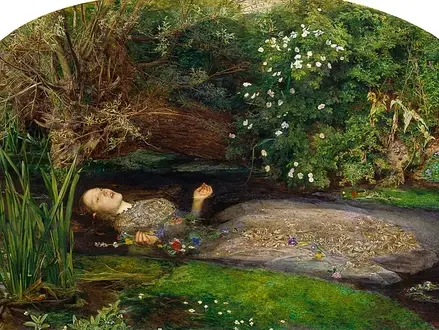Title of Artwork: “Ophelia”

Artwork by John Everett Millais
Year Created 1851-1852
Summary of Ophelia
A symbol of the early Pre-Raphaelite movement, Millais’ Ophelia shows the moment in Shakespeare’s Hamlet when Hamlet’s beloved, driven crazy by sorrow following her father’s death, jumps into a brook and drowns herself. Her eerie facial expression is highlighted by the rich natural tones of her natural surroundings as she floats on her back in murky water with her arms spread. When it comes to applying paint, Millais has the uncommon ability to apply it with a deftness of touch that catches light, textures and natural features with remarkable accuracy. The painting of Ophelia, on the other hand, was a harrowing experience for the artist. When he was creating the setting for Ophelia on the Hogsmill River near Ewell, he worked eleven-hour days and complained to Thomas Combe’s wife in a letter:
“In comparison to other martyrdoms, this one is the most difficult. The flies in Surrey are stronger and more prone to exploring human flesh than other insects. Threatened with a summons to appear before the magistrate, I’m also in danger of being carried into the water by the wind and becoming acquainted with the feelings of Ophelia as she sank to muddy death, along with the (less likely) total disappearance, through the voracity of flies, as she sank to her death in the mud. It’s hard to think of a more severe penalty for a killer than painting a portrait under these conditions “It’s true.
All About Ophelia
Elizabeth Siddal, the young lady who served as the inspiration for Ophelia, was the real-life inspiration for the tragic heroine. Siddal was painted over the course of four months by laying in a warm bath for hours at a time. Siddal was left with a severe fever when the under-tub heating failed after one session. When Millais refused to pay Elizabeth’s medical bills, her father threatened him with legal action, so he agreed to do so (which he did). However, her presence in this picture is made all the more painful because of her connection to a third protagonist: Dante Gabriel Rossetti, a colleague of Millais. Rossetti’s muse, Siddal, had been with him for some years before their marriage in 1860. They had a troubled relationship because to Rossetti’s incessant philandering and Siddal’s chronic illness and depression. After the stillbirth of the couple’s daughter in 1862, she developed postpartum depression and died a few days later from an overdose of laudanum. If the overdose was unintentional or purposeful, we don’t know for sure.
Information Citations
En.wikipedia.org, https://en.wikipedia.org/.

























